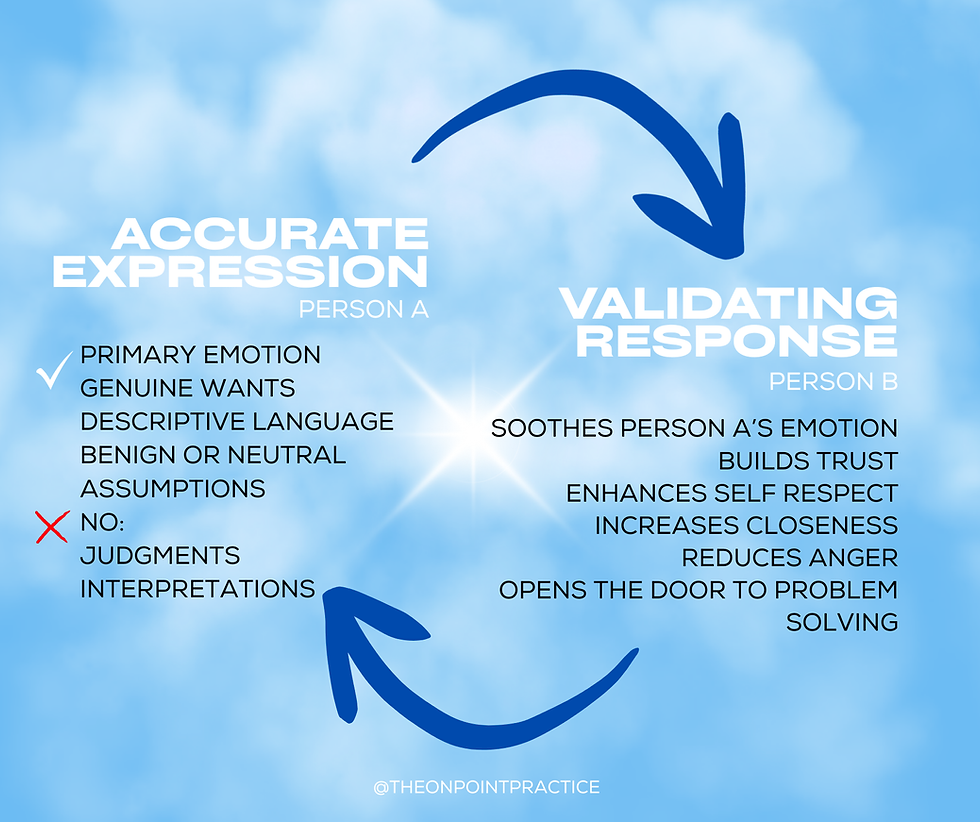Understanding Dialectical Behavior Therapy (DBT): A Comprehensive Guide
- Jenna Evans

- Jul 26
- 4 min read
Updated: Sep 23
Dialectical Behavior Therapy (DBT) is one of the most effective therapeutic approaches for individuals struggling with emotion dysregulation, self-destructive behaviors, and challenges in interpersonal relationships. While DBT is a specialized form of Cognitive Behavioral Therapy (CBT), it has unique aspects that set it apart. In this post, I’ll answer four common questions people have about DBT, including how it works, how it differs from other therapies, how long treatment takes, and what to look for in DBT providers.
What is DBT Therapy?
DBT was developed by psychologist Marsha Linehan and her team in the late 1980s as a treatment for individuals with Borderline Personality Disorder (BPD). However, many randomized control studies have proven its benefits for people struggling with various mental health challenges, such as depression, anxiety, trauma, and self-harming behaviors. DBT is a form of cognitive-behavioral therapy that incorporates mindfulness, acceptance, and change-focused techniques. Its primary aim is to help individuals manage intense emotions, reduce self-destructive behaviors, and improve interpersonal relationships.
The combination of its cognitive-behavioral structure with additional mindfulness and acceptance-based tenets makes DBT a powerhouse. This blend allows clients to accept themselves and others as they are while learning new tools and strategies to enhance their lives.
How is DBT Different from Other Forms of Talk Therapy?
Traditional talk therapy often focuses on understanding the root causes of mental health issues, exploring past experiences, and discussing feelings. In these sessions, a client typically spends most of the hour processing or unloading their thoughts. In contrast, DBT is much more structured and goal-oriented. A session usually begins with setting an agenda, ensuring both the therapist and client know what to focus on and what they hope to achieve during their time together.
While some time can be spent exploring the roots of issues, DBT emphasizes present-moment experiencing and often involves practicing new behaviors in real-time. Additionally, therapists frequently incorporate diary cards for tracking mood and behaviors, and they assign homework to help clients continue their work outside of therapy sessions.
How Long Does DBT Treatment Usually Take?
The duration of DBT treatment can vary from person to person, but comprehensive DBT typically involves at least one year of treatment. Comprehensive DBT consists of four components: 1) individual therapy, 2) skills training, 3) phone coaching, and 4) the therapist's involvement in a consultation team. Some programs offer comprehensive DBT, while others provide DBT-informed therapy or individual therapy only. These alternative versions may uphold the same principles of DBT but do not offer the full treatment as originally designed.
The length of DBT treatment is due to its structured approach, which helps individuals gradually build and reinforce new skills. Some clients may need ongoing maintenance sessions after the initial year, depending on their progress and needs. The structured nature of DBT allows ample time to focus on both immediate concerns, such as managing crises, and long-term goals, like emotional regulation and improving relationships. The time you spend in DBT may vary based on your treatment targets and personal goals.

What Should You Look for in a DBT Therapist?
Finding the right therapist is crucial for a successful therapeutic experience! An effective DBT therapist should have formal training in DBT and a solid understanding of its principles and techniques. In addition to technical expertise, a skilled DBT therapist often has an ongoing mindfulness practice, is part of a consultation team, and actively engages in DBT skills themselves. These are wonderful questions to ask your prospective DBT therapist to gauge their practice.
Other qualities that DBT therapists bring to clients include their ability to balance:
Acceptance & Change: Offering validation and empathy while also holding individuals accountable for learning and practicing new skills.
Structure & Flexibility: Using a hierarchy during sessions to prioritize certain behaviors while allowing space for what feels most relevant to the client.
Patience & Encouragement: Supporting clients to try something different, especially when they are navigating difficult emotions or setbacks.
Guiding the Treatment & Actively Involving the Client: Co-creating diary cards and agreeing on treatment plans and goals.
Therapists also play an important role in preventing therapy-interfering behaviors, such as missed sessions or lack of commitment to treatment, and see themselves as active participants in the therapeutic process.
The Benefits of DBT
DBT offers numerous benefits that can lead to lasting change. Here are a few key advantages:
Improved Emotional Regulation
One of the primary goals of DBT is to help individuals learn how to regulate their emotions more effectively. By developing skills to manage intense feelings, clients can reduce impulsive behaviors and improve their overall emotional well-being.
Enhanced Interpersonal Skills
DBT teaches valuable interpersonal skills that can improve relationships. Clients learn how to communicate more effectively, set boundaries, and navigate conflicts in healthier ways.
Increased Mindfulness
Mindfulness is a core component of DBT. Clients practice being present in the moment, which can lead to greater self-awareness and a deeper understanding of their thoughts and feelings.
Greater Self-Acceptance
DBT encourages clients to accept themselves as they are while also striving for personal growth. This balance can foster a more compassionate relationship with oneself.
Conclusion
I hope these answers provide clarity on the four common questions we often receive about DBT. Are you ready to take the next step in your journey? Book your free consultation call today to get started.
On Point Practice is ready when you are.
Would you like to see more posts answering common Q's about DBT?
Yes Please!
This was sufficient.
You can vote for more than one answer.



.png)



Comments